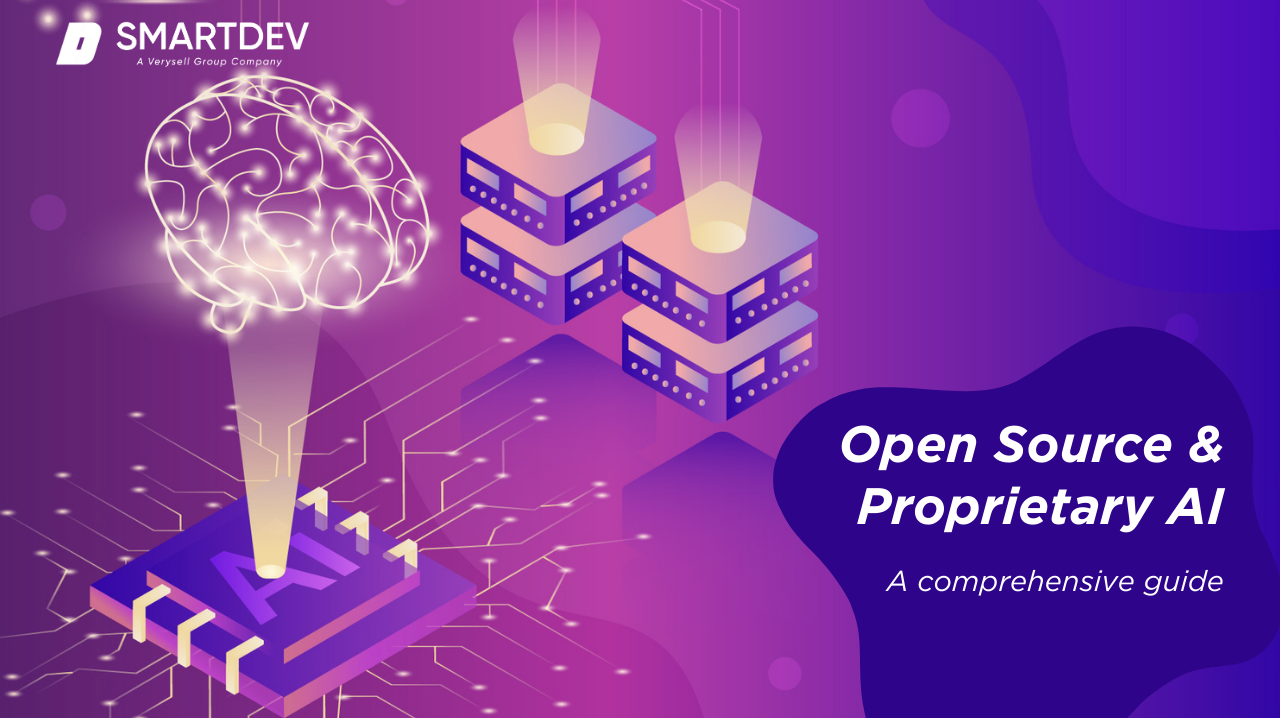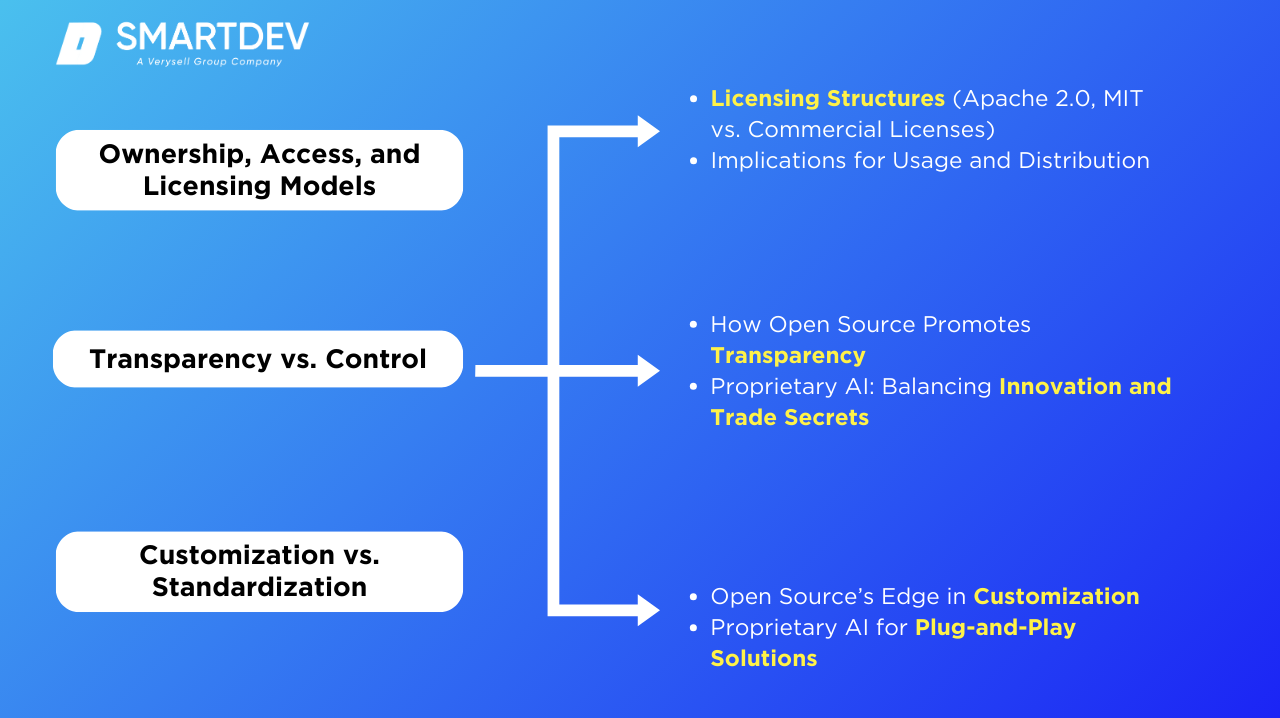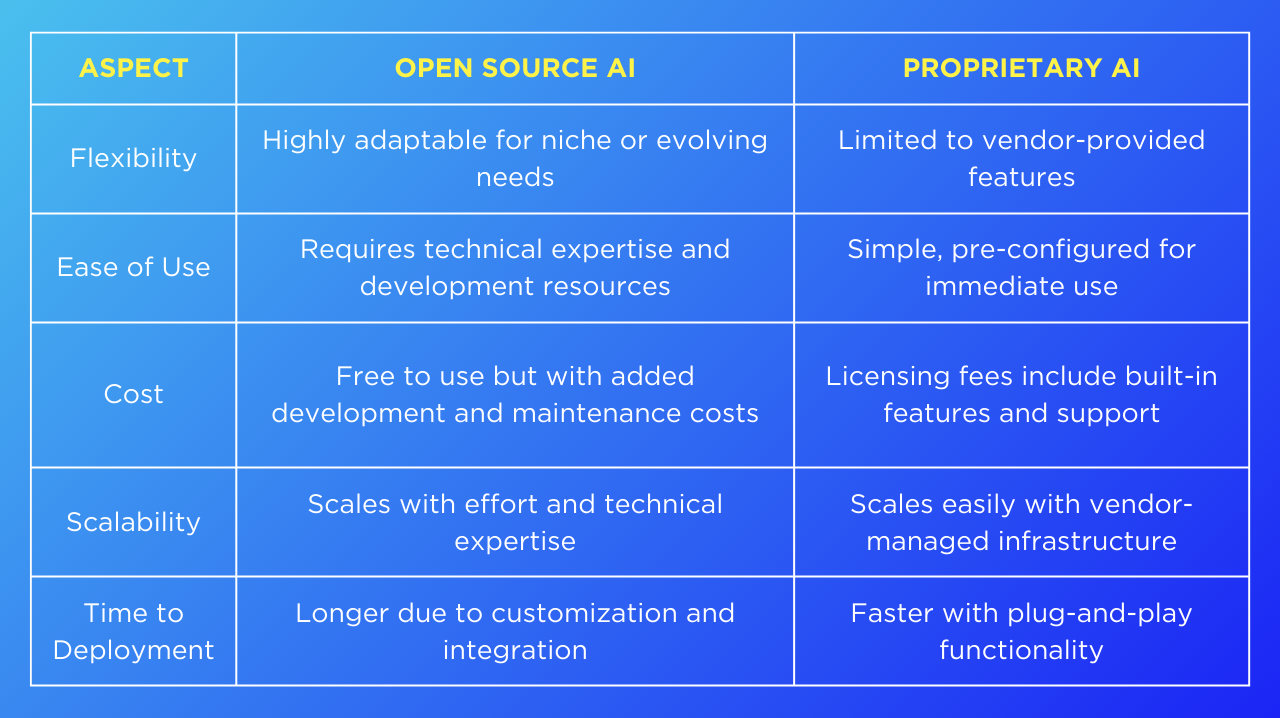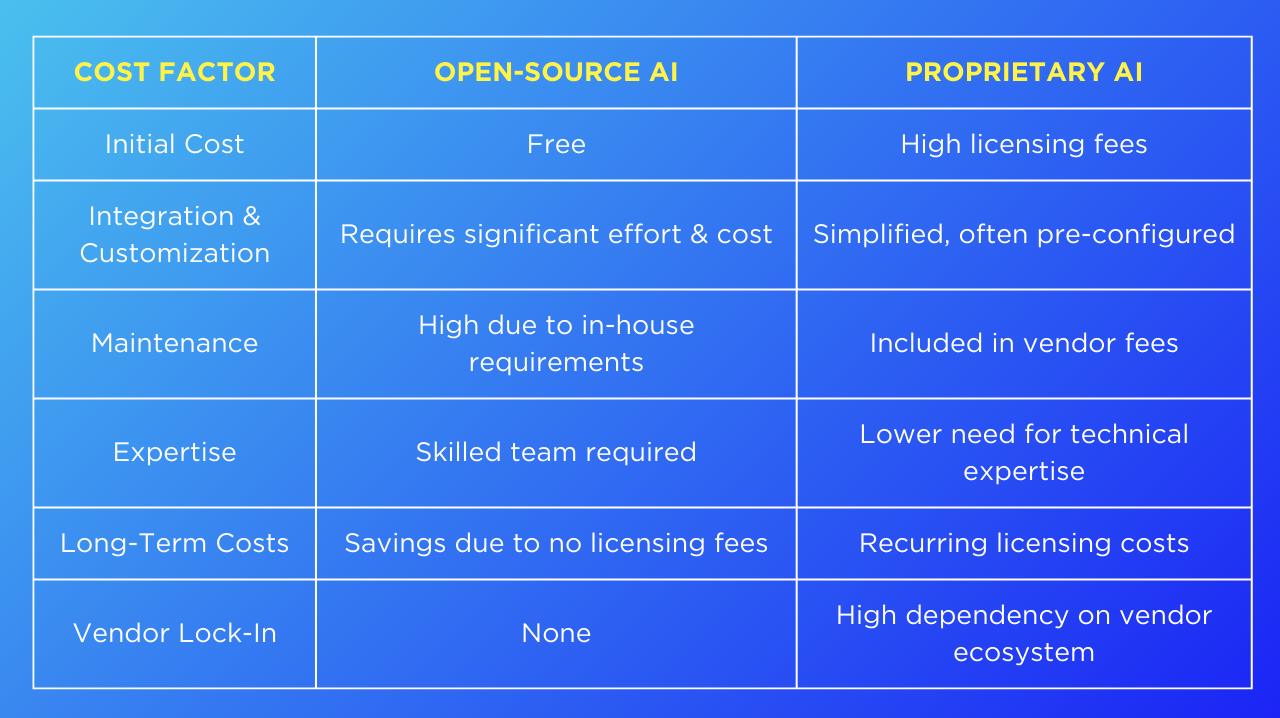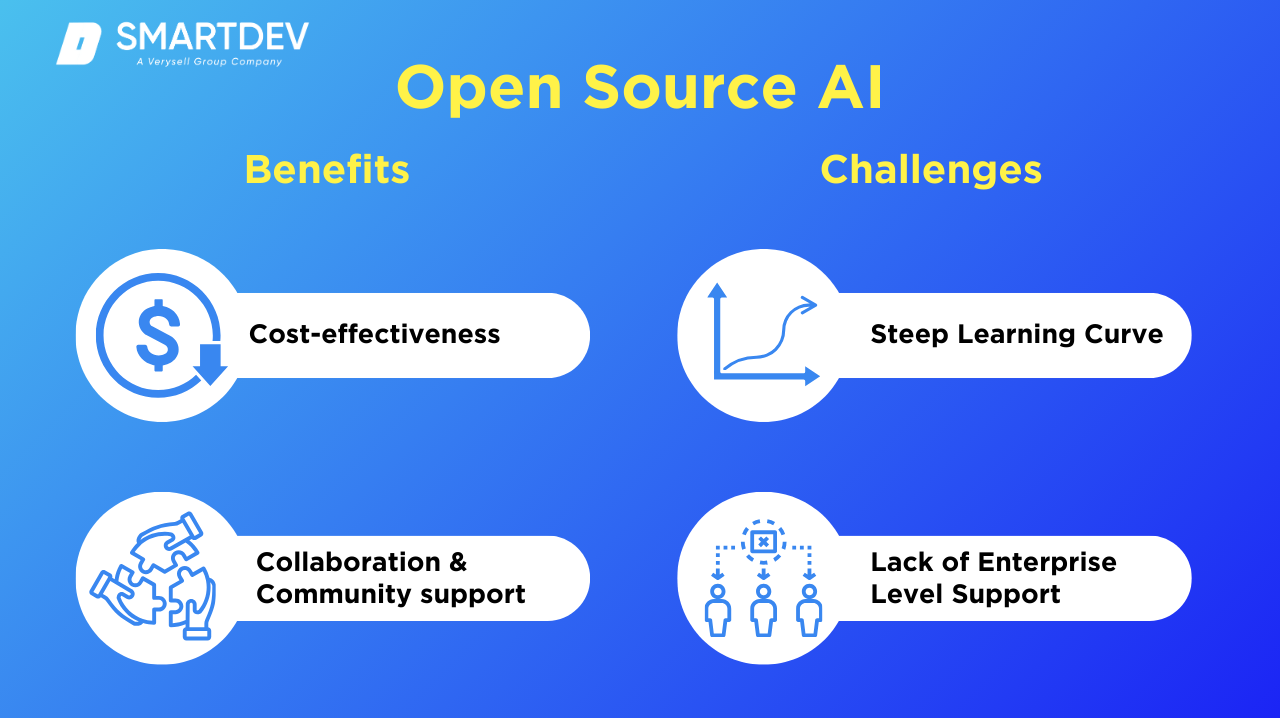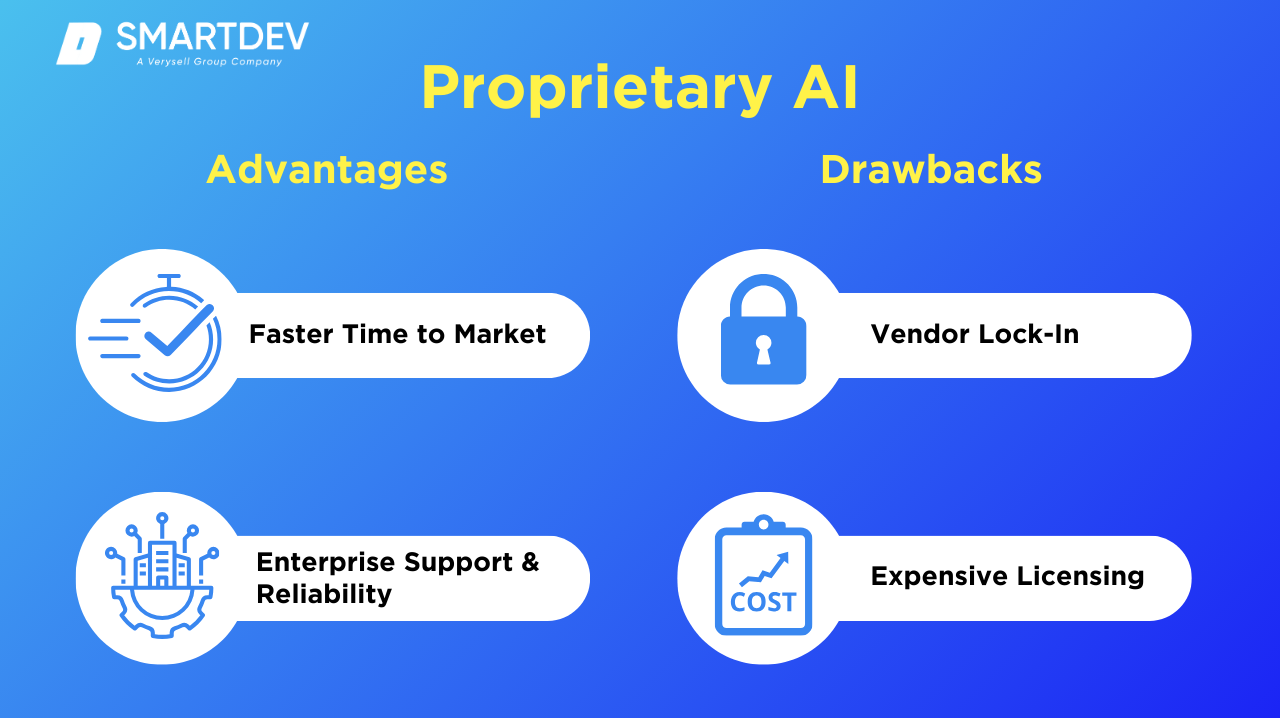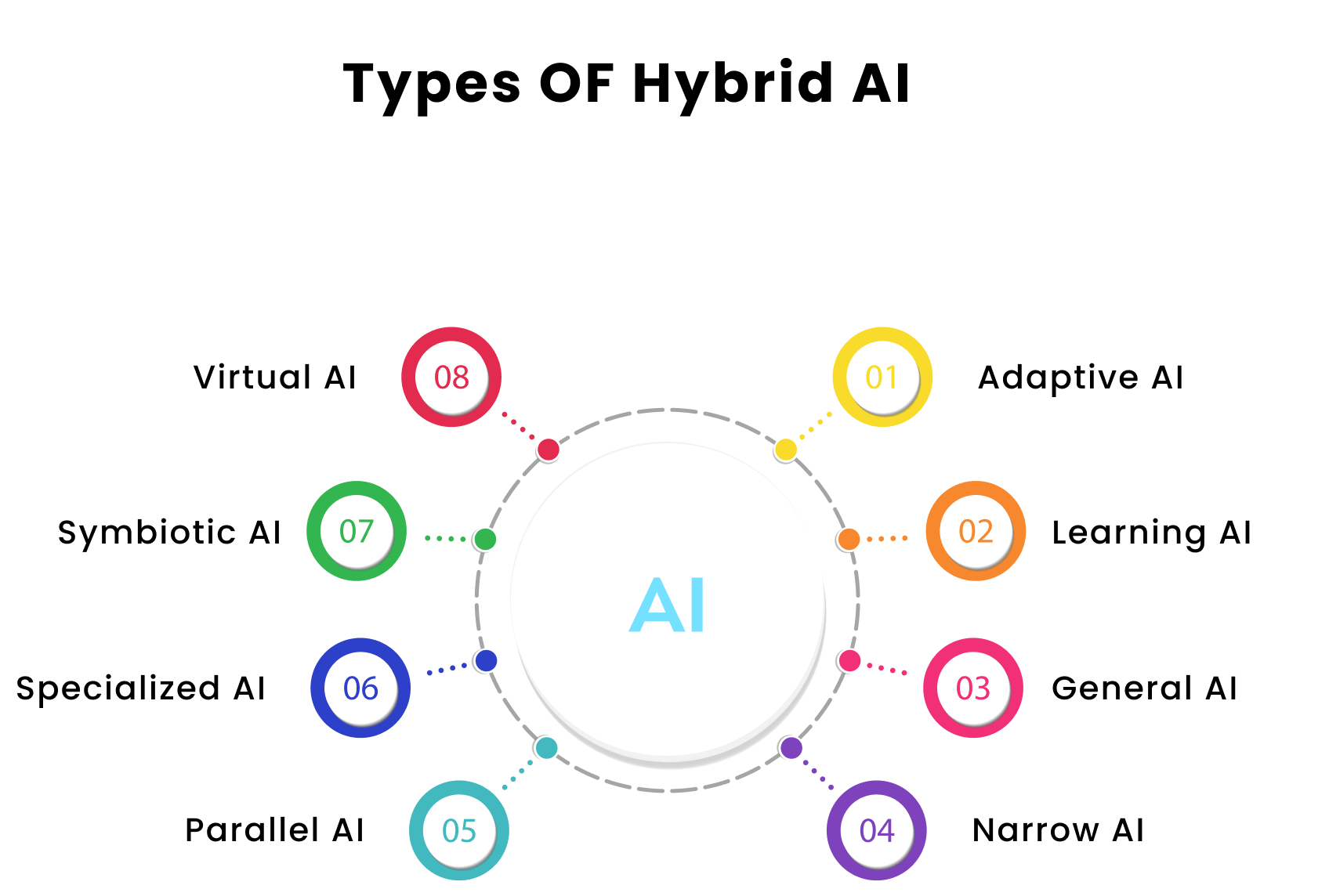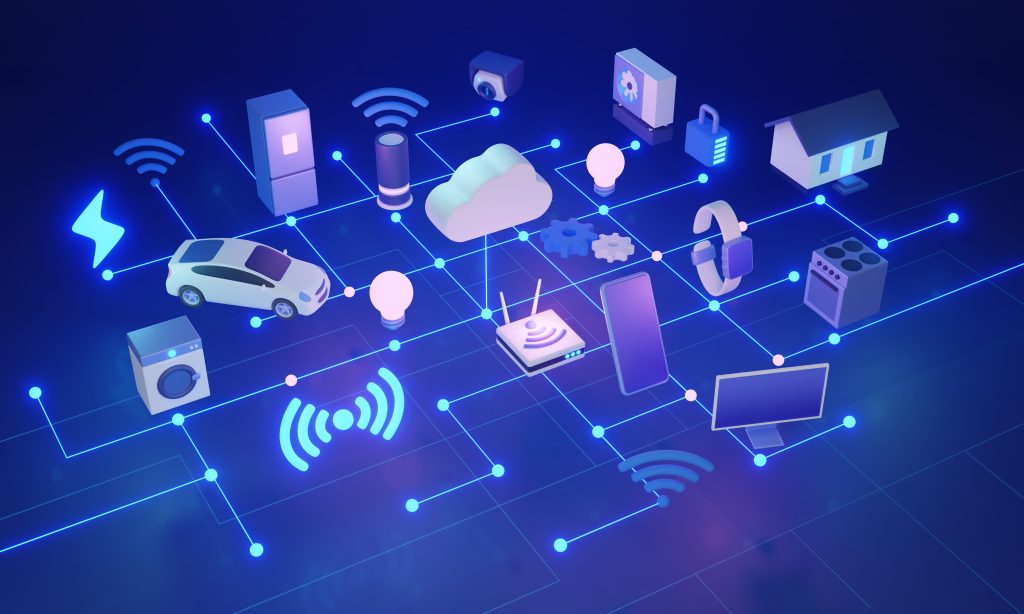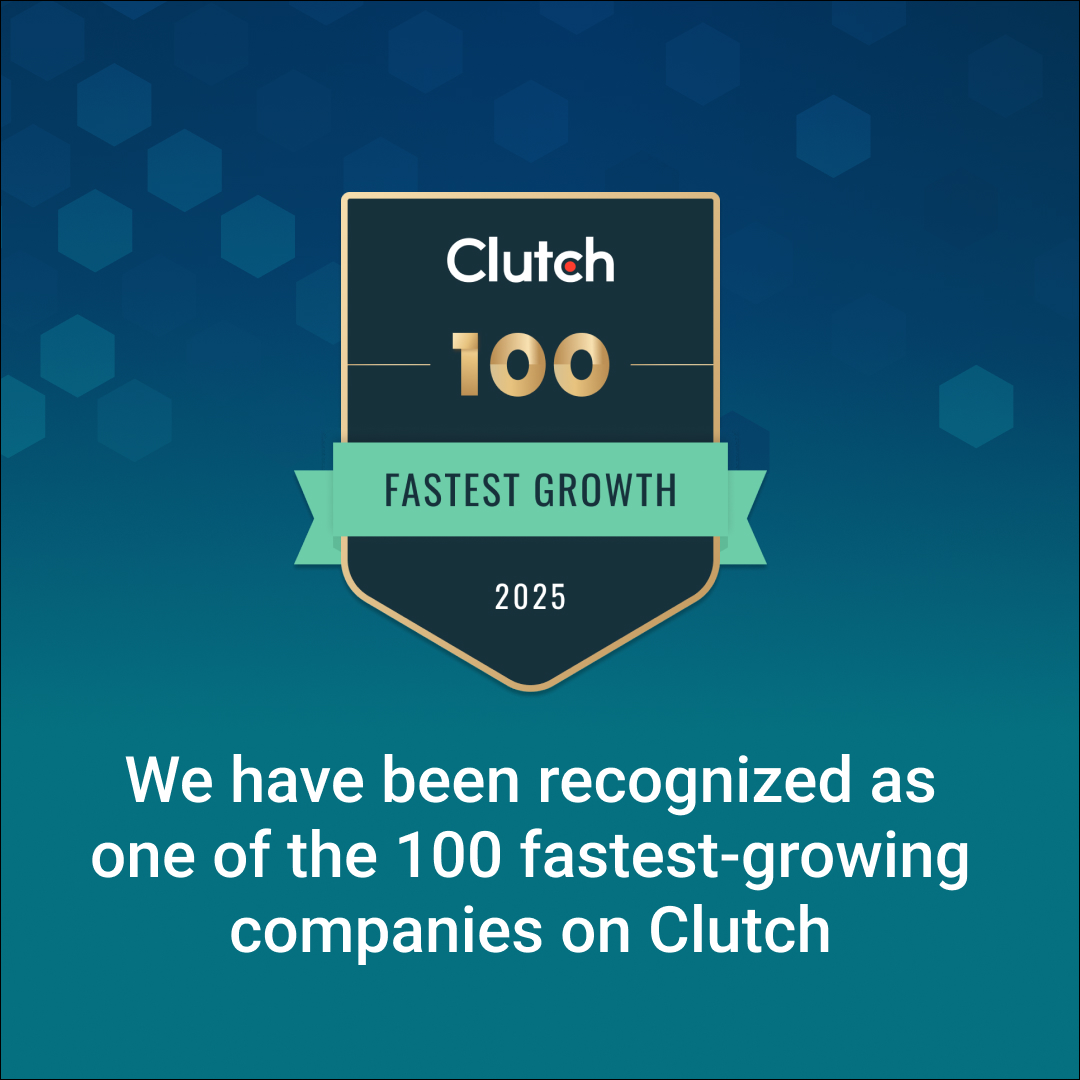Introduction
In today’s landscape where companies are driven towards the immense stream of technology, Artificial Intelligence (AI) has become the cornerstone of innovation across different industries.
From automating processes to optimizing business decisions, AI continues to unlock greater growth opportunities as more and more businesses invest in AI research and applications. This article will dissect the current landscape, the benefits and weaknesses of Open Source vs Proprietary AI, to equip businesses with the ultimate guide for AI application.
As you navigate the evolving landscape of open-source and proprietary AI, it’s important to see how these choices translate into real-world business impact. For organizations seeking to turn AI innovation into robust, production-ready solutions, our AI-powered software development services provide the expertise and end-to-end support needed to deliver measurable results.
AI’s Pivotal Role in Modern Enterprises
AI has become integral to modern enterprises, driving efficiency, innovation, and strategic decision-making. Key roles of AI in contemporary business include (Rashid and Kausik, 2024):
- Operational Efficiency: AI automates routine tasks, streamlines processes, and enhances productivity. For instance, AI-driven chatbots handle customer inquiries, while machine learning algorithms optimize supply chain logistics.
- Data-Driven Decision-Making: AI analyzes vast datasets to extract actionable insights, supporting strategic planning and forecasting. This capability enables businesses to make informed decisions based on real-time data analysis.
- Personalization and Customer Experience: AI tailors products and services to individual customer preferences, enhancing satisfaction and loyalty. Generative AI, for example, enables personalized consumer experiences by analyzing behavior patterns.
Choosing between open-source and proprietary AI frameworks goes beyond simple technical preferences; it shapes an organization’s ability to innovate, adapt, and scale.
Open-source tools foster collaboration and transparency, often accelerating the pace of innovation. Proprietary solutions, on the other hand, provide reliability, support, and fine-tuned features tailored to specific use cases.
The story of AI’s evolution is a tale of two approaches: open innovation and corporate ownership. Open innovation, epitomized by projects like TensorFlow and PyTorch, thrives on collective intelligence. It relies on global communities of developers, researchers, and enthusiasts who contribute to, critique, and refine the codebase.
Conversely, corporate ownership has given rise to proprietary AI models, with organizations like OpenAI and IBM leading the charge. These firms invest heavily in research and development, producing polished, powerful solutions like GPT-4 and Watson. Proprietary AI often comes with a price tag, but it’s justified by robust performance, dedicated support, and seamless integrations for enterprise clients.
What Does Open Source and Proprietary Mean in AI?
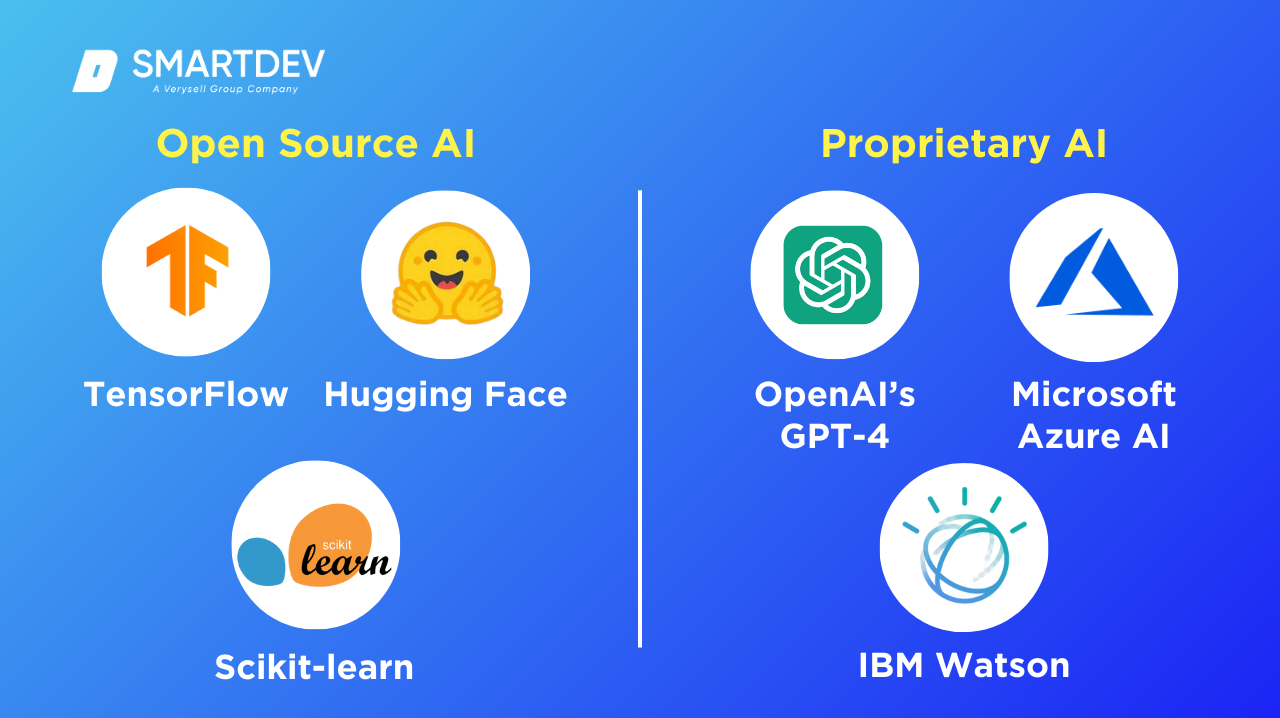
Open source refers to frameworks, libraries, or models whose source code is publicly available. These solutions can be freely used, modified, and distributed, often under licenses like Apache 2.0 or MIT. Open source’s ethos is rooted in community-driven development, encouraging experimentation and collaboration. (Yaniv Benhamou, 2024)
Examples of Open Source AI
- TensorFlow: Google’s flagship machine learning framework is a versatile tool for building and deploying AI models, particularly in deep learning.
-
Hugging Face: Known for democratizing natural language processing, Hugging Face provides a vast library of pre-trained models and tools for building conversational AI.
- Scikit-learn: A go-to for machine learning in Python, scikit-learn supports tasks like classification, regression, and clustering.
Proprietary AI, by contrast, denotes software or models owned and controlled by an organization. Access to these tools is restricted, often requiring a license or subscription. While proprietary solutions may lack the customizability of open-source options, they excel in offering high-quality, enterprise-grade performance with guaranteed support.
Examples of Proprietary AI
- OpenAI’s GPT-4: A sophisticated language model renowned for its advanced natural language understanding and generation, GPT-4 powers applications from chatbots to content creation tools.
- IBM Watson: A comprehensive suite of AI services tailored for industries like healthcare, finance, and retail, IBM Watson exemplifies enterprise-ready AI with features like natural language processing and predictive analytics.
- Microsoft Azure AI: A cloud-based suite of AI services that integrates seamlessly with Microsoft’s ecosystem, providing businesses with scalable and secure AI capabilities.
Core Differences Between Open Source and Proprietary AI
1.1. Ownership, Access, and Licensing Models
Licensing Structures (Apache 2.0, MIT vs. Commercial Licenses): Licensing models are the backbone of how AI tools are distributed and used.
Open-source licenses like Apache 2.0 and MIT grant users broad freedoms, allowing modification, redistribution, and even commercial use. Apache 2.0, in particular, includes patent protections, making it a favorite for enterprise-grade applications. MIT, being simpler and permissive, is often preferred for rapid prototyping and smaller projects.
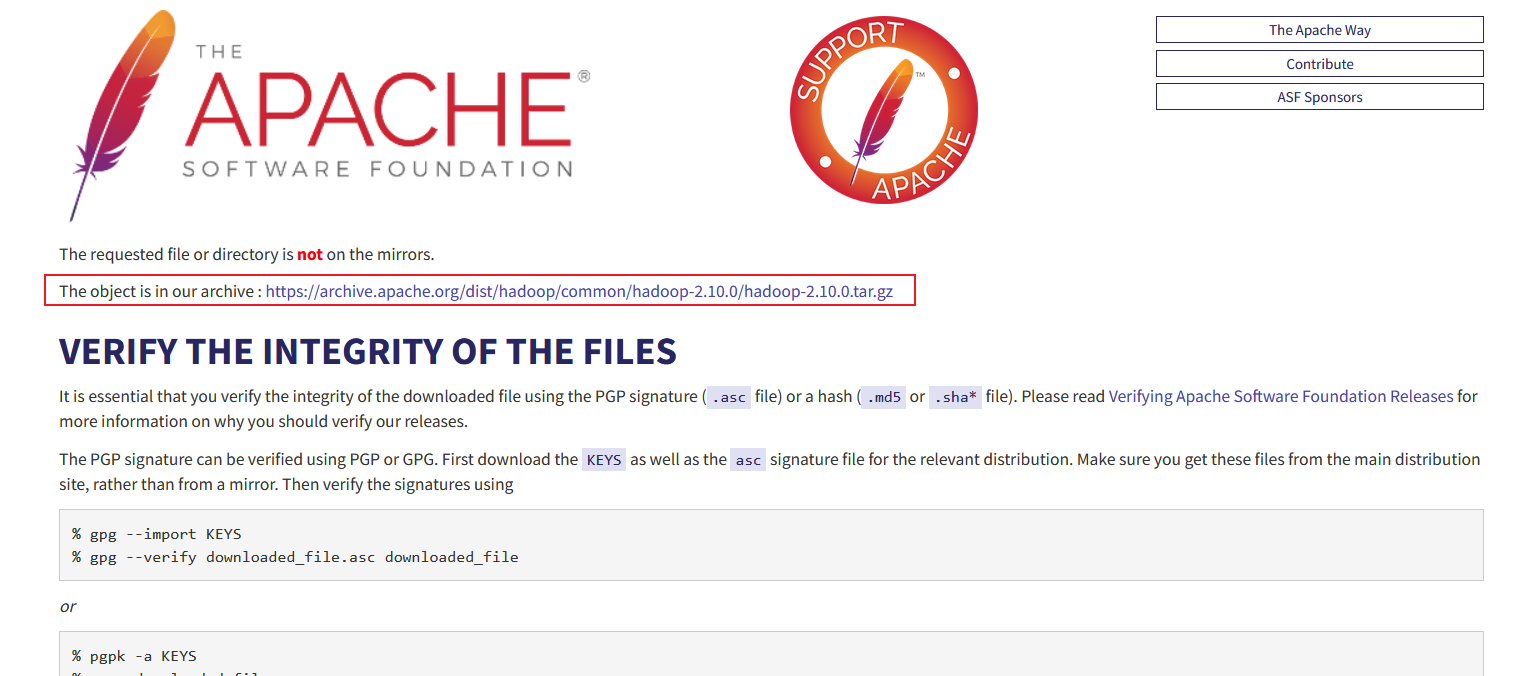
Source: Apache 2.0 license
On the other hand, proprietary AI operates under commercial licenses. These licenses typically restrict access, requiring users to purchase subscriptions or licenses. While this limits flexibility, it ensures that enterprises receive dedicated support, regular updates, and robust security measures tailored to their needs.

1.2. Implications for Usage and Distribution:
The choice of licensing impacts not just access but also how AI tools can be used and shared. Open-source models enable developers to freely adapt and distribute AI solutions, fostering innovation and collaboration. However, they may lack warranties or support, placing the onus on the user to troubleshoot issues.
Proprietary AI, in contrast, is designed for controlled environments. Companies adopting such tools benefit from guaranteed performance, but redistribution or customization is often limited. This trade-off is crucial for organizations prioritizing stability over flexibility.
1.3. Transparency vs. Control (Michael Sacks, 2015)
Open-source AI thrives on transparency. With its publicly available codebase, developers can scrutinize algorithms, ensuring they align with ethical standards and are free from biases. This openness fosters trust and collaboration, making it easier to debug, improve, and innovate. For companies like SmartDev, this level of transparency is invaluable in ensuring compliance with data privacy and ethical AI regulations.
Proprietary AI operates in a more closed environment, balancing innovation with the need to protect trade secrets. While the underlying algorithms and training data are often confidential, this approach ensures a competitive edge. For enterprises seeking reliability and exclusive features, proprietary AI’s controlled framework is a compelling choice, albeit at the expense of transparency.
1.4. Customization vs. Standardization
Open-source AI is synonymous with customization. Developers have the freedom to tweak algorithms, add features, or integrate the tools into unique workflows. This adaptability makes open-source solutions ideal for businesses with niche requirements or those looking to innovate rapidly.
Proprietary AI, on the other hand, excels in offering plug-and-play solutions. These tools are pre-configured for ease of use, requiring minimal setup. For organizations that prioritize speed and scalability over customization, proprietary solutions provide a reliable, hassle-free pathway to AI adoption.
2. Key Factors to Consider When Choosing AI
Uncover the essential factors for choosing the right AI solution. This section dives into cost comparisons, security protocols, scalability, and innovation speed, helping you weigh Open Source’s flexibility against Proprietary AI’s enterprise-ready features. Make an informed decision with confidence!
2.1. Cost Analysis
The Total Cost of Ownership (TCO) is a vital consideration when deciding between open-source and proprietary AI solutions. While open-source AI tools are initially free, their true cost emerges through integration, customization, and maintenance. Proprietary AI, in contrast, has higher upfront licensing fees but can reduce costs related to implementation time, support, and compliance. Understanding the full spectrum of costs helps businesses make informed decisions.
Open Source AI:
- Low Initial Costs: Open-source AI tools like TensorFlow, PyTorch, and Scikit-learn are freely available, eliminating licensing expenses. This makes them attractive for startups and organizations experimenting with AI.
- Hidden Costs of Integration and Maintenance: Integrating open-source tools into existing systems requires skilled developers, often leading to higher labor costs. Customization, regular updates, and troubleshooting further add to the expense.
- Ongoing Expertise Requirements: Open-source AI demands a technically proficient team to manage configurations, optimize performance, and ensure security. This expertise may be costly to hire or train, especially for organizations without a strong in-house tech team.
- Long-Term Savings: Despite higher labor costs, open-source solutions offer flexibility and avoid recurring licensing fees, potentially resulting in long-term savings for businesses that can manage the technical complexity.
Proprietary AI:
- High Initial Costs: Proprietary AI solutions, such as IBM Watson or Salesforce Einstein, require significant upfront licensing fees. These fees often include bundled features, support, and compliance tools, which reduce additional expenses.
- Simplified Implementation: Proprietary solutions come pre-configured for specific industries or use cases, minimizing the time and effort required for deployment. This lowers costs associated with integration and reduces time to market.
- Ongoing Costs: Licensing fees are typically recurring and can increase with scale. However, these solutions often include updates, support, and maintenance, which mitigate the need for a large in-house technical team.
- Vendor Lock-In Risks: Proprietary AI’s dependence on a specific vendor may lead to long-term costs when scaling or migrating to a different solution, reducing flexibility and increasing dependency on the vendor’s pricing model.
Hidden Costs: Integration, Maintenance, and Expertise
Open-Source AI: While free to use, open-source tools often reveal hidden costs in integration, requiring significant effort to align them with existing systems. Maintenance involves regular monitoring, updates, and troubleshooting, which demand skilled personnel. These costs can grow exponentially as projects scale.
Although proprietary AI minimizes hidden costs through vendor support and built-in integrations, it may introduce indirect costs, such as reduced flexibility and the inability to adapt quickly to changing business needs. Vendor lock-in can make switching or modifying solutions expensive and time-consuming.
Discover More: AI Development Cost: The Ultimate Guide
2.2. Security and Privacy Concerns
Open-source AI fosters collaborative security measures. The transparency of open-source code allows global experts to identify vulnerabilities, share fixes, and build trust. This community-driven approach enhances security but requires active involvement from adopters to stay updated.
Proprietary AI excels in security through dedicated enterprise-grade protocols. Vendors often implement rigorous compliance measures, ensuring tools meet regulatory standards. While users must trust the vendor’s security practices, this approach reduces the burden on internal teams.
 2.3. Scalability and Performance
2.3. Scalability and Performance
Open-source AI offers unparalleled flexibility in scaling. Organizations can modify the code to optimize performance for specific workloads. This adaptability makes open-source solutions ideal for startups and enterprises experimenting with diverse AI applications.
Proprietary AI solutions are designed to deliver streamlined performance at scale. Vendors ensure that tools are optimized for high-demand scenarios, providing reliable, scalable solutions that minimize downtime and operational complexity.
2.4. Speed of Innovation
Open-source AI thrives on community-driven innovation. Developers worldwide contribute to improving features and addressing challenges, resulting in rapid advancements. This collaborative environment fosters creativity and experimentation.
Proprietary AI benefits from significant R&D investments by corporations. These investments drive innovation, producing state-of-the-art tools and features that often outpace open-source counterparts in specific domains. While users benefit from cutting-edge capabilities, they rely on the vendor’s roadmap for updates.
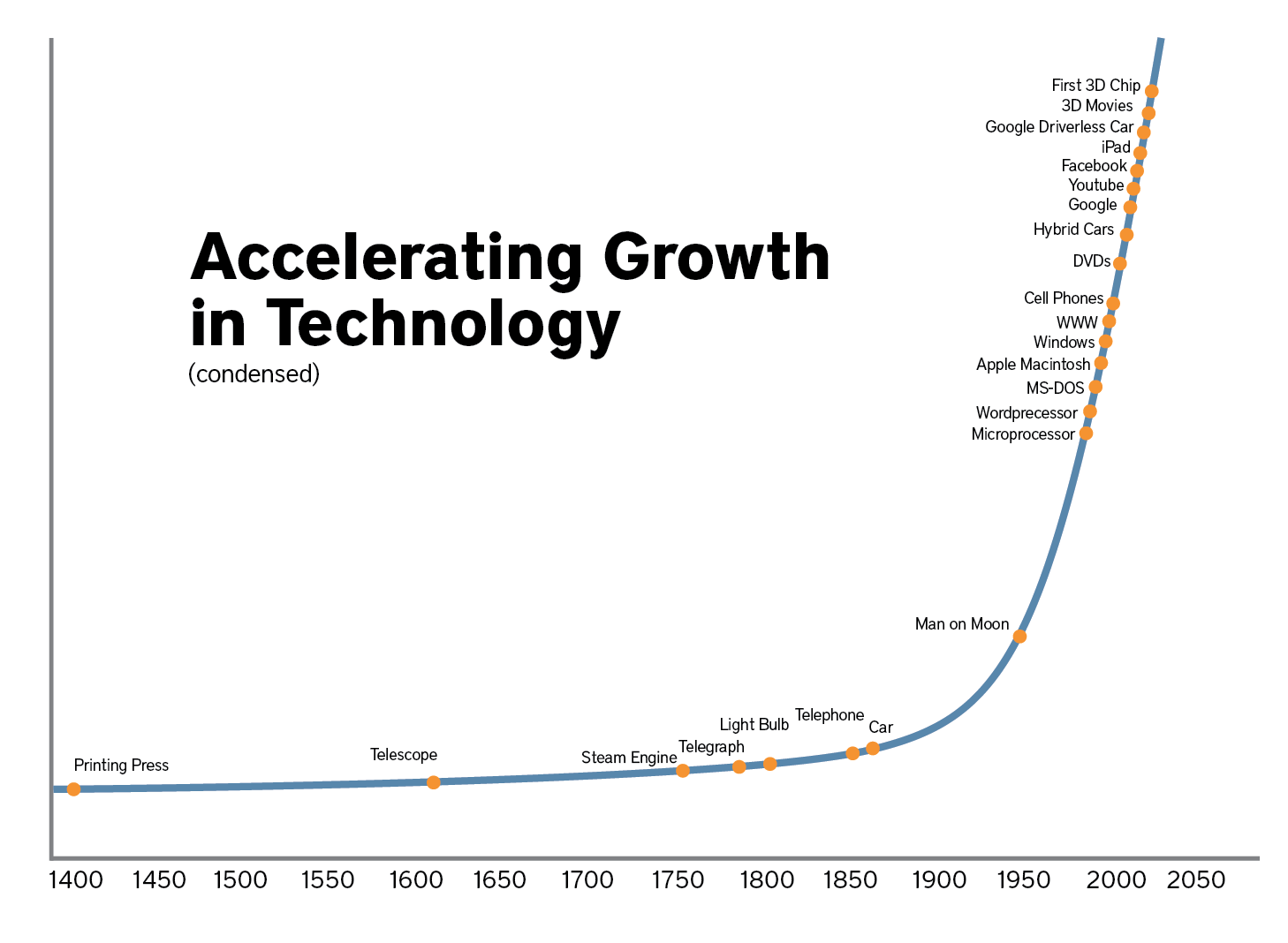
Source: Peter Fisk
3. Use Cases and Real-World Applications
Explore real-world applications of Open Source and Proprietary AI. Learn who benefits most from each—academic institutions, startups, or regulated industries—and dive into success stories like Hugging Face in NLP and IBM Watson in healthcare. Discover the AI path that suits your goals!
3.1. Who Uses Open Source AI? (Tyler Weitzman, 2024)
Open-source AI’s accessibility and flexibility make it a favorite among academic institutions, startups, and enterprises.
Academic Institutions utilize open-source AI frameworks such as TensorFlow, PyTorch, and Hugging Face to conduct cutting-edge research and education without the financial constraints of proprietary software. Moreover, Academic researchers contribute to and benefit from the open-source community, sharing advancements and collaboratively solving global challenges.
- Open-source AI tools provide startups with the flexibility to experiment, prototype, and scale solutions quickly with cost-effective budget.
- Established enterprises often leverage open-source AI frameworks for targeted projects, such as predictive maintenance in manufacturing or enhancing customer personalization in retail. Many also combine open-source tools with in-house proprietary solutions to optimize costs while maintaining control over core technologies.

The research process of OpenScholar
Source: Allen Institute for AI and University of Washington
3.2. Who Prefers Proprietary AI?
Regulated Industries: Proprietary AI solutions offer robust security features essential for industries like healthcare, finance, and aerospace. These sectors handle sensitive data and require AI systems that comply with strict security protocols to prevent breaches and unauthorized access. These AI tools are designed to meet specific industry regulations such as HIPAA for healthcare, GDPR for data protection, and SOX for financial reporting. Proprietary vendors often provide documentation and support to help organizations maintain compliance effortlessly.
Large Enterprises: Large enterprises typically have complex IT ecosystems. Proprietary AI solutions are engineered to integrate smoothly with existing infrastructure, including legacy systems, databases, and enterprise software, minimizing disruption during deployment. These solutions are built to handle large volumes of data and high user loads, ensuring consistent performance across global operations. Proprietary AI can scale vertically and horizontally to meet the growing demands of large organizations.
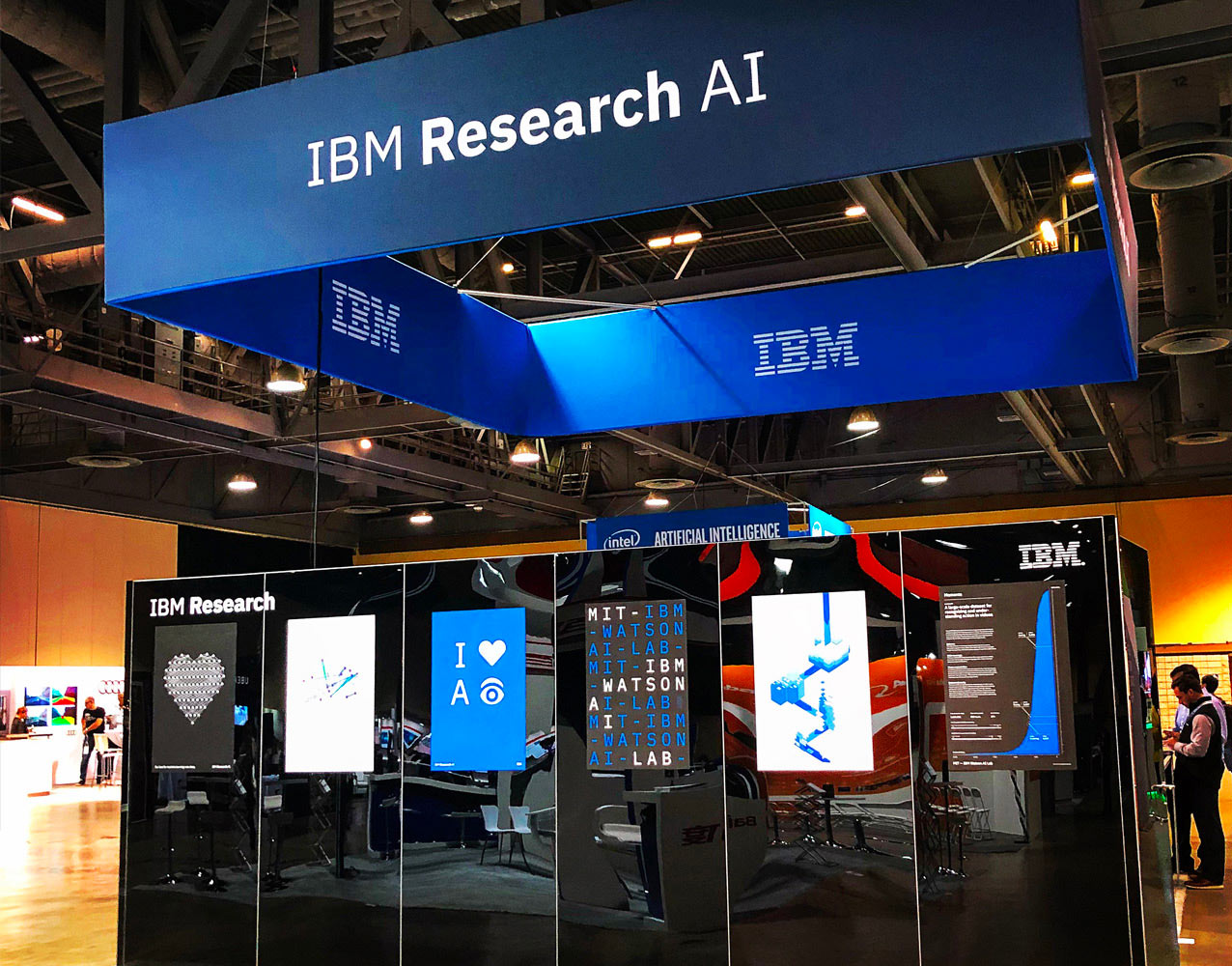
Source: IBM use of AI for research
3.3. Case Studies: Success Stories
a. Open Source AI Success: Hugging Face in NLP (Schmid, Boudier and Funtowicz, 2024)
Hugging Face has significantly impacted the NLP field by providing open-source tools, notably the Transformers library. This resource offers pre-trained models for various NLP tasks, including text classification, machine translation, and question answering.
Impact: The user-friendly interface and comprehensive documentation of Hugging Face have enabled developers and researchers to fine-tune advanced models like BERT, GPT, and T5. This accessibility has facilitated the development of applications such as chatbots, sentiment analysis platforms, and personalized recommendation systems across diverse industries.
Real-life Applications:
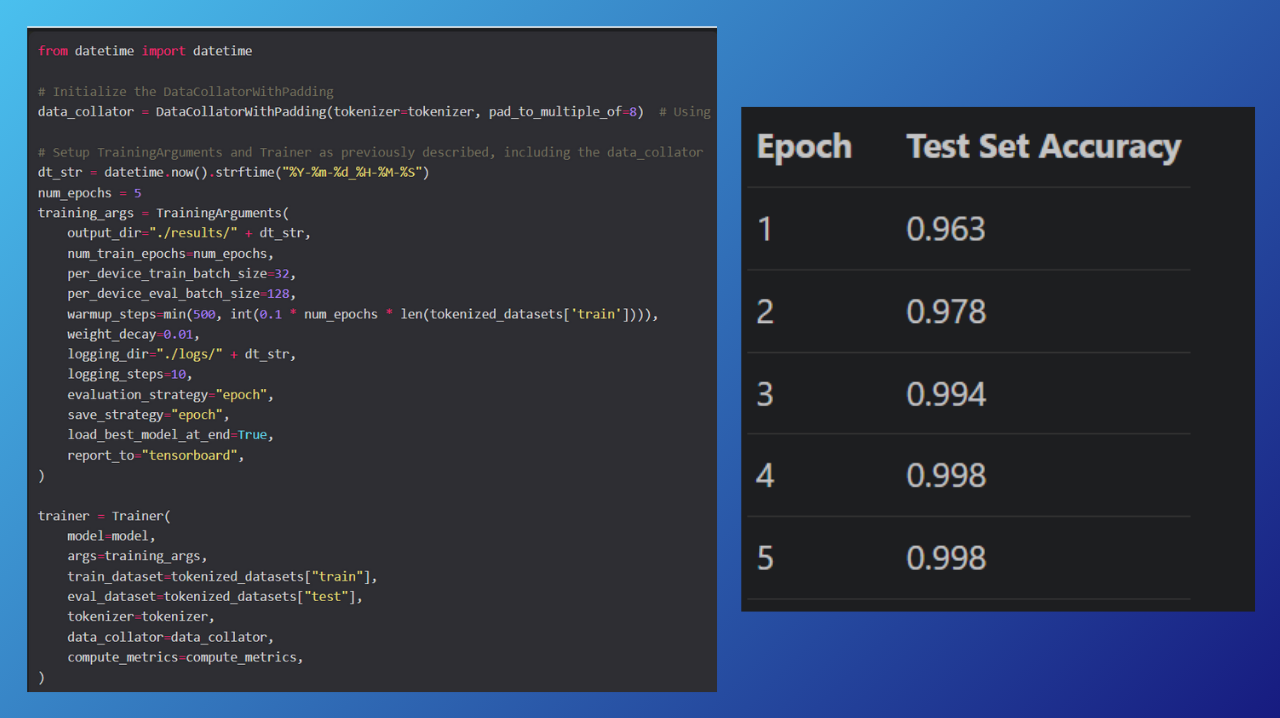
Source: Hunter Heidenreich
Sarcasm Detection in Text: A practical case study demonstrated the use of Hugging Face’s Transformers library to fine-tune a pre-trained model for sarcasm detection, highlighting the library’s adaptability for specialized NLP tasks. (Hunter Heidenreich, 2024)
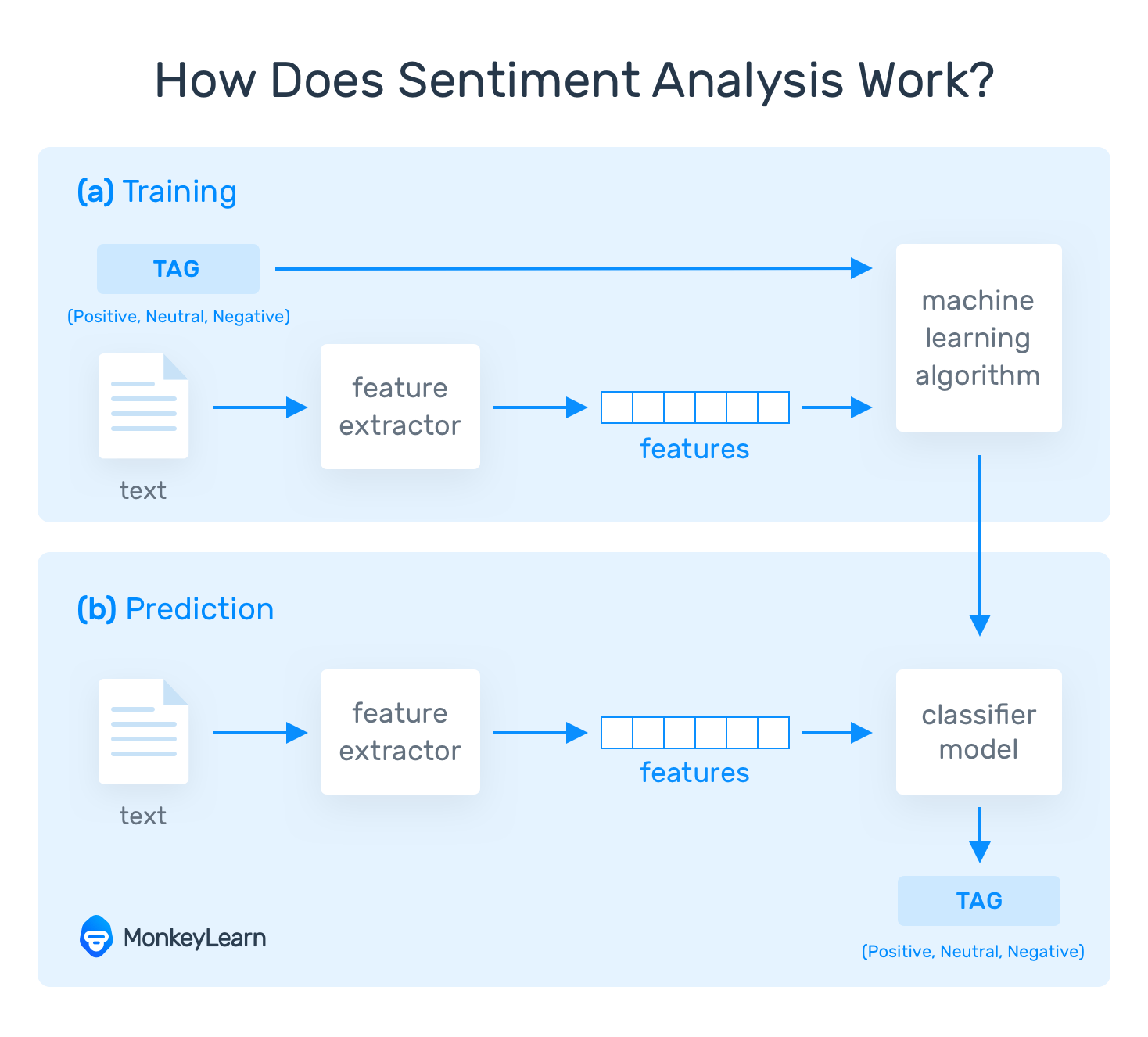
Source: MonkeyLearn
Sentiment Analsis: Researchers have explored the impact of Hugging Face’s Transformer library on sentiment analysis, applying pre-trained models to gather data more efficiently and accurately, thereby enhancing the performance of sentiment analysis systems. (Chhabra, Chaudhary and Alam, 2023)
b. Proprietary AI Triumph: IBM Watson in Healthcare
IBM Watson exemplifies the transformative potential of proprietary AI solutions in the healthcare sector. By integrating advanced analytics and natural language understanding, Watson assists in analyzing extensive medical data, thereby supporting clinical decision-making processes.
Impact: IBM Watson Health provides AI-powered tools that aid healthcare professionals in analyzing medical data, identifying potential diagnoses, and developing personalized treatment plans. The platform emphasizes transparency, ensuring that medical practitioners understand the AI system’s operations and the rationale behind its conclusions.
Real-life Applications:
Clinical Decision Support: TidalHealth Peninsula Regional implemented IBM Micromedex with Watson, an AI-powered clinical decision support solution, to integrate evidence-based medical information into their electronic health records. This integration enabled clinicians to access reliable answers within their workflow, enhancing efficiency and patient care. (IBM, 2024).

Source: IBM
Healthcare Provider Assistance: Humana utilized IBM Watson to develop a virtual assistant that handles inquiries from healthcare providers regarding patient insurance coverage. This AI-driven solution reduced the need for direct human intervention, leading to cost savings and improved response rates.

Source: IBM
4. Pros and Cons: The Comparative Analysis
Open Source and Proprietary AI when used accordingly can become an extremely powerful tool for people and businesses. Hence, it is a growing need to adapt those AI applications that are suitable for specific requirements.
4.1. Benefits of Open Source AI
Open-source AI fosters collaboration among developers worldwide. The active communities behind these tools contribute to debugging, feature development, and documentation, creating an ecosystem of shared knowledge and innovation. By supporting and contributing to open-source AI projects, enterprises enhance their brand reputation, attract top talent, and stay ahead in technological advancements.
One of the most significant advantages of open-source AI is its cost-effectiveness. With no licensing fees and the flexibility to modify and deploy as needed, organizations can allocate resources to development rather than expensive software. It eliminates licensing fees, allowing them to allocate budgets to other critical areas, such as product development or market expansion.
4.2. Challenges of Open Source AI
Complexity in Implementation: Open-source AI frameworks like TensorFlow, PyTorch, and Scikit-learn often require advanced programming skills and in-depth knowledge of machine learning concepts. Organizations lacking experienced developers may struggle to implement these tools effectively.
Customization Challenges: While flexibility is a strength of open-source AI, it often involves writing custom code to adapt models for specific use cases. This can be time-intensive and prone to errors, particularly for teams without substantial expertise.
Training and Onboarding: The steep learning curve for open-source tools necessitates training programs for team members, which can delay project timelines and increase costs. For smaller organizations or startups, this poses a significant barrier to adoption. A case study from the healthcare sector highlighted that deploying an open-source NLP model required months of training for the IT staff, delaying the project’s launch and increasing overall costs.
Community-Driven Support: Open-source AI relies on community forums, GitHub repositories, and online documentation for troubleshooting. While these resources are extensive, they are often fragmented, and responses to critical issues can take time.
No Service-Level Agreements (SLAs): Unlike proprietary AI vendors, open-source platforms typically do not offer SLAs, leaving organizations without guarantees for uptime, bug fixes, or performance optimization. This can be a critical drawback during time-sensitive operations or system outages.
Integration and Maintenance Gaps: Open-source tools may not seamlessly integrate with existing enterprise systems. When issues arise, organizations must rely on in-house expertise or external consultants, adding complexity and cost. A fintech company using an open-source AI fraud detection system reported significant downtime during peak transaction periods because immediate support from the community was unavailable, leading to lost revenue and customer dissatisfaction.
4.3. Advantages of Proprietary AI
Comprehensive Support Packages: Proprietary AI vendors provide extensive support services, including 24/7 technical assistance, tailored training programs, and dedicated account managers. This ensures that businesses have reliable help whenever issues arise, minimizing downtime and disruptions.
Guaranteed Service Levels: Many proprietary AI providers offer service-level agreements (SLAs) that guarantee system uptime, performance benchmarks, and response times for troubleshooting. These guarantees are essential for industries where downtime can lead to significant financial or reputational losses.
Regular Updates and Maintenance: Proprietary solutions include regular updates, security patches, and new feature rollouts, ensuring that the technology remains up-to-date and secure without requiring in-house expertise to manage these tasks. A logistics company leveraging proprietary AI for route optimization cited consistent support from the vendor during peak holiday seasons as critical in avoiding delivery delays, which would have impacted customer satisfaction and profitability.
Pre-Configured Solutions: Proprietary AI tools often come with pre-built functionalities, workflows, and templates tailored for specific industries or use cases. This reduces the need for extensive customization and accelerates deployment timelines.
Turnkey Implementation: Unlike open-source solutions, which may require significant development efforts, proprietary AI can be implemented with minimal setup, allowing organizations to focus on achieving business outcomes rather than technical challenges.
Reduced Risk During Deployment: The out-of-the-box reliability of proprietary AI minimizes errors during implementation and reduces the need for trial-and-error configurations, enabling smoother rollouts. A retail chain implemented a proprietary AI-powered customer personalization platform, reducing deployment time from several months (with an open-source alternative) to just weeks. This expedited the launch of a holiday marketing campaign that significantly boosted sales.
4.4. Drawbacks of Proprietary AI
Restricted Ecosystem: Proprietary AI solutions often lock organizations into a vendor’s ecosystem, making it difficult to integrate with other tools or platforms. This limits flexibility, especially if business needs evolve or new technologies emerge.
Challenges in Switching Providers: Moving away from a proprietary system involves high costs, such as data migration, retraining staff, and potential downtime. This dependency can discourage businesses from exploring better or more cost-effective alternatives.
Limited Customization: While proprietary tools offer robust features, they are generally less customizable than open-source options. Organizations may find it difficult to tailor solutions to their unique needs without relying on expensive vendor services. A telecom company using a proprietary customer analytics tool struggled to integrate the platform with its new CRM system, incurring additional costs and delays due to incompatibility.
High Upfront Costs: Proprietary AI solutions typically require significant initial investments in licensing fees, which can strain budgets, particularly for startups and smaller organizations.
Recurring Fees: Beyond upfront costs, ongoing expenses such as annual maintenance, support, and upgrade fees can add up, impacting long-term ROI. Businesses may find these costs unsustainable as their needs grow.
Budget Constraints for Innovation: The expense of proprietary AI can divert funds away from other innovation initiatives, such as hiring skilled personnel or investing in complementary technologies. A healthcare provider found that licensing a proprietary diagnostic AI tool was 70% more expensive than building a comparable open-source system in-house, limiting the organization’s ability to invest in other patient care technologies.
5. Future Outlook and Trends
5.1. The Rise of Hybrid AI Models: Combining Open Source with Proprietary Features
Hybrid AI models represent a new paradigm in artificial intelligence, blending the best of open-source and proprietary approaches. Organizations can leverage open-source frameworks like TensorFlow for flexibility and innovation, while integrating proprietary features to ensure reliability, compliance, and enterprise-grade support.
For example, many companies use open-source models as a foundation, adding proprietary enhancements such as specialized algorithms, premium APIs, or secure cloud integrations. This approach allows businesses to balance customization and control, scaling AI solutions to meet diverse operational needs without being entirely dependent on one methodology.
Hybrid AI not only fosters innovation but also enables cost optimization. By utilizing free or low-cost open-source tools for initial development and adding proprietary elements selectively, companies can achieve a tailored solution that aligns with both budgetary and performance goals.
5.2. Regulatory Impacts on Open Source vs. Proprietary AI
Regulatory compliance is a critical factor in AI adoption, particularly in industries like healthcare, finance, and government. Open-source AI provides transparency, allowing organizations to audit code for adherence to regulations like GDPR or HIPAA. However, the lack of built-in compliance features in some open-source tools can pose challenges.
Proprietary AI often comes equipped with features and certifications that simplify compliance. Vendors ensure their tools meet industry standards, providing peace of mind for enterprises navigating complex regulatory landscapes. This makes proprietary solutions a preferred choice for organizations prioritizing compliance.
Governments worldwide are increasingly turning to open-source AI for its cost-effectiveness and transparency. Open-source tools allow public institutions to avoid vendor lock-in and promote local innovation. Countries like India and France have launched initiatives leveraging open-source frameworks for national AI strategies, highlighting its potential for public-sector applications.
5.3. Open Source AI and Ethical AI Development
One of open-source AI’s standout advantages is its alignment with ethical AI principles. Transparency in algorithmic decisions is essential to building trust and accountability. Open-source frameworks allow developers and organizations to examine the decision-making process, ensuring fairness and minimizing biases.
Proprietary AI vendors are also stepping up their commitments to ethical AI. Companies like Microsoft and IBM have introduced frameworks for responsible AI development, focusing on fairness, inclusivity, and environmental sustainability. While proprietary solutions may lack the inherent transparency of open-source tools, these initiatives aim to address ethical concerns in closed systems.
Conclusion,
6.1 Choosing the right AI for your business need
Selecting the right AI solution—whether open-source or proprietary—is a pivotal decision that can shape the future of your business. The key lies in aligning your choice with your organization’s specific goals, resources, and long-term strategy.
When deciding, start by defining your business goals. Are you looking for a cost-effective way to experiment with AI, or do you need a robust, enterprise-grade system with extensive support? Open-source AI may suit startups and teams focused on innovation with limited budgets, while proprietary AI is ideal for industries that require compliance, security, and scalability.
To simplify the process, use a decision framework that balances short-term needs with long-term growth. Consider factors like your technical capabilities, budget constraints, integration requirements, and the level of support your team needs to operate effectively.
6.2. Deciding Framework Based on Business Goals
Align your AI choice with your broader strategic objectives. Consider factors like:
- Scalability: Will the solution grow with your business?
- Integration: Can it fit seamlessly into your existing systems?
- Support Needs: Does your team require hands-on assistance, or are they equipped to navigate open-source platforms independently?
A clear framework helps narrow down your options and ensures that your decision aligns with both current requirements and long-term vision.
6.3. Checklist for Evaluation
To make an informed decision, use a checklist to evaluate each AI solution:
- Define measurable goals for your AI initiative (e.g., reduce operational costs by 20%, improve customer satisfaction).
- Assess your technical resources and determine if additional training or hires are needed.
- Compare costs, including licensing fees, maintenance, and implementation.
- Check for compliance features to meet industry regulations.
- Evaluate the vendor or community support available for troubleshooting and updates.
- Review success stories or case studies relevant to your industry for real-world insights.
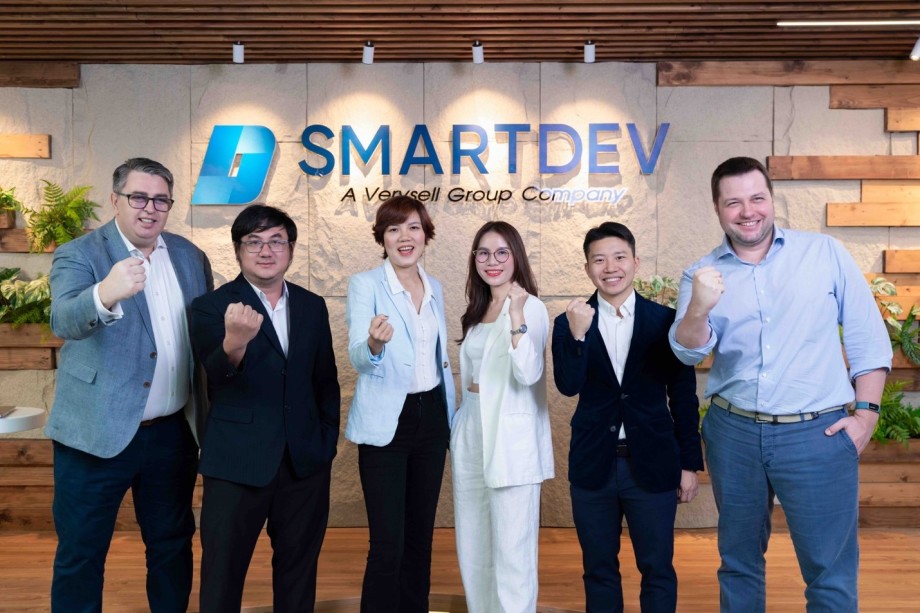
SmartDev Board of Directors
At SmartDev, we understand that the path to leveraging AI can feel overwhelming. With our expertise in ITO solutions, we can guide you through this critical decision-making process. Whether you’re aiming to adopt cutting-edge open-source tools or integrate enterprise-grade proprietary solutions, our team of experts is here to ensure your AI journey is seamless and impactful.
Remember, the right AI solution is not just about the technology—it’s about how it empowers your business to innovate, grow, and stay competitive in a rapidly evolving landscape.
7. FAQs
1. What is the key difference between open-source and proprietary AI?
The main difference lies in accessibility and ownership. Open-source AI is freely available, allowing developers to modify and share the code, making it ideal for customization and experimentation. Proprietary AI, on the other hand, is owned by a vendor, requiring licenses for use but offering comprehensive support, enterprise-grade features, and built-in compliance measures.
2. Which is better for enterprises: open-source or proprietary AI?
The better choice depends on the enterprise’s goals and resources. Open-source AI is well-suited for organizations with strong technical expertise and a need for customization, allowing them to innovate cost-effectively. Proprietary AI is ideal for enterprises that need robust, ready-to-deploy solutions with vendor support, particularly in regulated industries or for large-scale applications.
3. Is open-source AI secure?
Open-source AI can be secure if implemented and maintained properly. However, it requires organizations to monitor for vulnerabilities, apply updates, and follow security best practices. Proprietary AI often has built-in security measures and vendor-managed updates, making it a safer option for businesses with limited security resources.
4. What are the costs involved with open-source and proprietary AI?
Open-source AI is free to access but may require significant investment in development, maintenance, and training, depending on the complexity of the project. Proprietary AI comes with licensing fees but often reduces upfront effort with pre-configured solutions, vendor support, and maintenance included in the cost.
5. Can open-source AI compete with proprietary AI in terms of performance?
Yes, open-source AI can rival proprietary solutions in performance, especially for specialized use cases and innovation. However, proprietary AI often has an edge in user-friendliness, scalability, and integration with enterprise systems, which can be critical for large organizations.
—
References
- AI revolutionizing industries worldwide: A comprehensive overview of its diverse applications
- Open Source AI: Does the Copyleft Clause Propagate to Proprietary AI Models? Revisiting the Definition of Derivatives in the AI-context
- Competition Between Open Source and Proprietary Software: Strategies for Survival
- The Rise Of Open Artificial Intelligence: Open-Source Best Practices
- Case Study: Millisecond Latency using Hugging Face Infinity and modern CPUs
- Sarcasm Detection in Text: A Case Study Using Transformer Models
- Exploring Hugging Face Transformer Library Impact on Sentiment Analysis
- IBM Micromedex: Improving efficiency and care with AI

